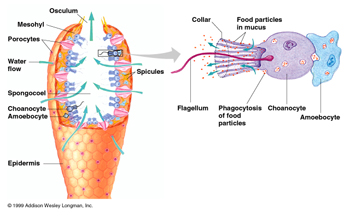There is no heart, no veins, no arteries, and no blood on the sponge. However, they achieve gas exchange and nutrient consumption through the movement of water. Water is drawn into the sponge through the inner choanocytes, and the inner choanocytes take up water from the outer pores of the sponge. Sponge does not ponder the meaning or origin of life. But in some respects, they are better than us in their entire lives. They have lived for millions of years and survive on the ocean floor by taking in nutrients through their porous bodies. To our eyes, they look almost funny and simple. They have no brains and, in fact, no nerve cells. Five Facts About Sponges Early fossil records show that sponges inhabited Earth about 600 million years ago. Some deep-sea sponges are more than 200 years old. The sponge is a master filter. They can filter 100,000 times more water every day! In other words, a.More.
Why do sponge cells have no heart?
Therefore, there is no such thing as the heart because there is no circulatory system or blood that conducts nutrients and gas. Sponge cells perform a variety of body functions and appear to be more independent of each other than cells of other animals.
Does the sponge have a brain?
The body of the sponge has neither the brain nor the central nervous system. Did you know that you have the ability to regrow the parts that your prey or other animals may have taken? Also, if you settle in another place, you can re-grow into a clone of your parents' body!
What are the five interesting facts about sponges?
Cool information about sponges. The sponge has no spine, so it is an invertebrate. They are considered one of the simplest animals on earth. They are also very colorful, strange and mysterious. Sponges have the ability to produce their own food.
Why does the sponge have a head and a back?
Jessica H. Sponge has no head and back. They are circular. The evolution of the head allows all sensory organs and nerves to concentrate in one area, leading to the brain.
Why are there no organs on the sponge?
Unlike protozoa, sponges are multicellular. However, unlike higher metazoans, the cells that make up the sponge are not organized into tissues. Therefore, the sponge lacks true tissue and organs. Moreover, they have no body symmetry.
Why don't sponges need organs to survive?
The sponge does not have true sensory organs, so it cannot hunt prey. Fortunately, they don't have to travel to find food. .. These cells are equipped with small tentacles called flagellas that move back and forth to draw water into the body of the sponge.
How does a sponge live without a brain?
The brain needs a lot of energy, and many of these simple creatures could not survive if they had to supply energy to the brain. In the case of sponge, there is no brain, digestive system, nervous system, or circulatory system. They simply filter the water for nutrients that have a finger-like structure called cilia.
Can the sponge be alive?
Sponges are one of the simplest multicellular organisms in the world. Yes, sponges are considered animals, not plants. However, they grow, reproduce and survive like plants. .. Sponges are one of the simplest multicellular organisms in the world.

Below you will find two helpful answers on a similar topic. 👇
Why is the Dove a symbol of peace?Can a sponge be alive?
